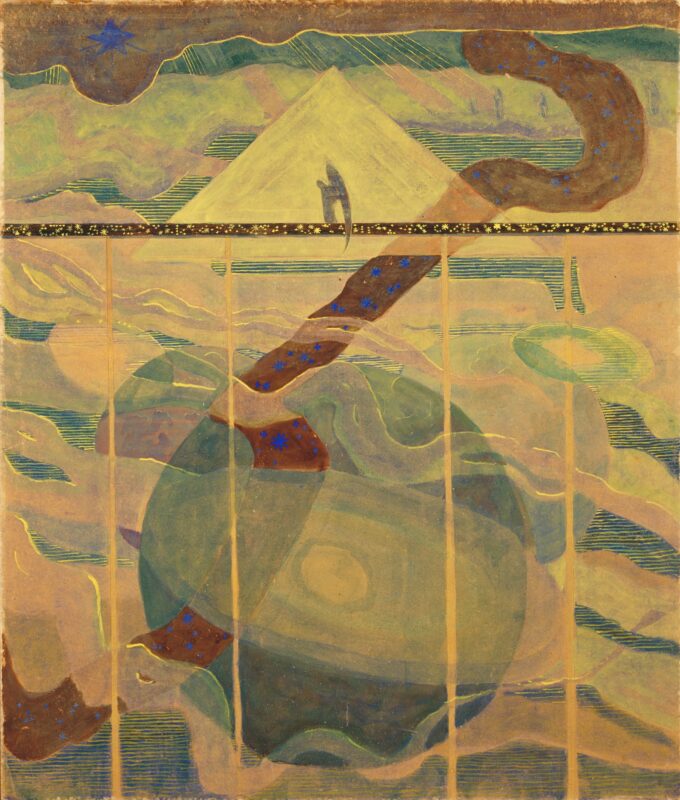100 Years in One Month: The Creation of a National Genius

Mikalojus Konstantinas Čiurlionis, Sonata No. 6 (Sonata of the Stars) Andante, 1908.
Mikalojus Konstantinas Čiurlionis (1875–1911), the son of an organist, thought of himself as being amongst the most famous musical figures in Europe. He studied in Warsaw and Leipzig, inspired by Richard Wagner he composed the symphonic poems The Sea and In the Forest, as well as writing mazurkas for the piano like Frédéric Chopin. In about 1901 he discovered painting and entered the Academy of Fine Arts in Warsaw. The symbols created by Čiurlionis reminded people of Odilon Redon, while he himself admired Arnold Böcklin. In nature Čiurlionis saw the footprints of history and put into pictorial form the sound of the soul earlier than Wassily Kandinsky, composed hypermodern piano preludes, presaging the dodecaphony of Arnold Schoenberg.
The Lithuanians began to worship him, when St Petersburg critics described ‘Čiurlionis, of Lithuanian descent’ as the best pupil that came out of the Academy of Fine Arts in Warsaw. Those lines in a newspaper were as if evidence of the recognition of the nation of Lithuania. But his fellow countrymen and countrywomen did not understand his visions. Čiurlionis himself expressed surprise at their low cultural level and determined to sweep away the detritus of foreign influences. Settling in Vilnius, he harmonized folk songs, led a choir and began to write an opera with the title of Jūratė to a libretto by his beloved Sofija Kymantaitė. All the same, his recognition as a local celebrity was not enough for him and he decided to move to St Petersburg. However, he was unable to find any work there, he felt alone, and the critics began to disparage him. Čiurlionis had a mental breakdown and died of pneumonia in a sanatorium near Warsaw.
Lithuania let out a collective gasp. The people close to him hurried to bring together his works, about 217 in number. Čiurlionis’s work was shown at a Mir iskusstva (World of Art) group exhibition in St Petersburg in 1909 and a year after his death the group organized a comprehensive exhibition of his work, drawing the attention of critics. In the same year the group arranged for three of his paintings to be included in the Second Post-Impressionist Exhibition in London. At the start of World War I Čiurlionis’s paintings were promptly taken to Moscow, where they were made popular by the poet and translator Jurgis Baltrušaitis.
After the Bolshevik revolution Čiurlionis, nationalized and returned to Kaunas, is already being regarded as the genius of the nation’s cultural renaissance. Romantic signs of Lithuanian identity and of Lithuania itself are recognized in his paintings. Čiurlionis is a perfect representative of the new state abroad: while exhibitions of folk art tell the story of a nation existing next to others over the ages, a modern genius is evidence of its modernity and vitality.
In 1938 the art historian Nikolai Vorobyov presents him to the world already as a creator in the European tradition, seeking for harmony between music and art, a visual expression of musical rhythms, multidimensional forms and an elemental dynamic. But the work of making this Lithuanian artist better known was cut short by the war.
After the war it was not even possible to speak about Čiurlionis since to the Soviet authorities he was a bourgeois mystic. However, it then became clear that he was valued by the Soviet writer Maxim Gorky: ‘Why don’t we have a Čiurlionis? After all, that’s musical painting!’ The screws of control were loosened. The centenary of Čiurlionis’s birth was celebrated with exhibitions, concerts and publications. In 1979 the art historian Eberhard Roters on seeing his work at the exhibition in West Berlin called it ‘a European sensation’.
And Čiurlionis most probably would say the same thing again: ‘They praised [my work], of course, a lot, but precisely only what was not worth praising, but what was really me and new, it seems, they did not understand […]. I would like to be understood.’
Agnė Narušytė